Key takeaways:
- Displays should create emotional connections by engaging consumers through storytelling and interactive experiences.
- Key elements for impactful displays include visual hierarchy, color psychology, interactive features, and clear messaging.
- Measuring display success through customer engagement metrics and feedback incorporates valuable insights for future improvements.
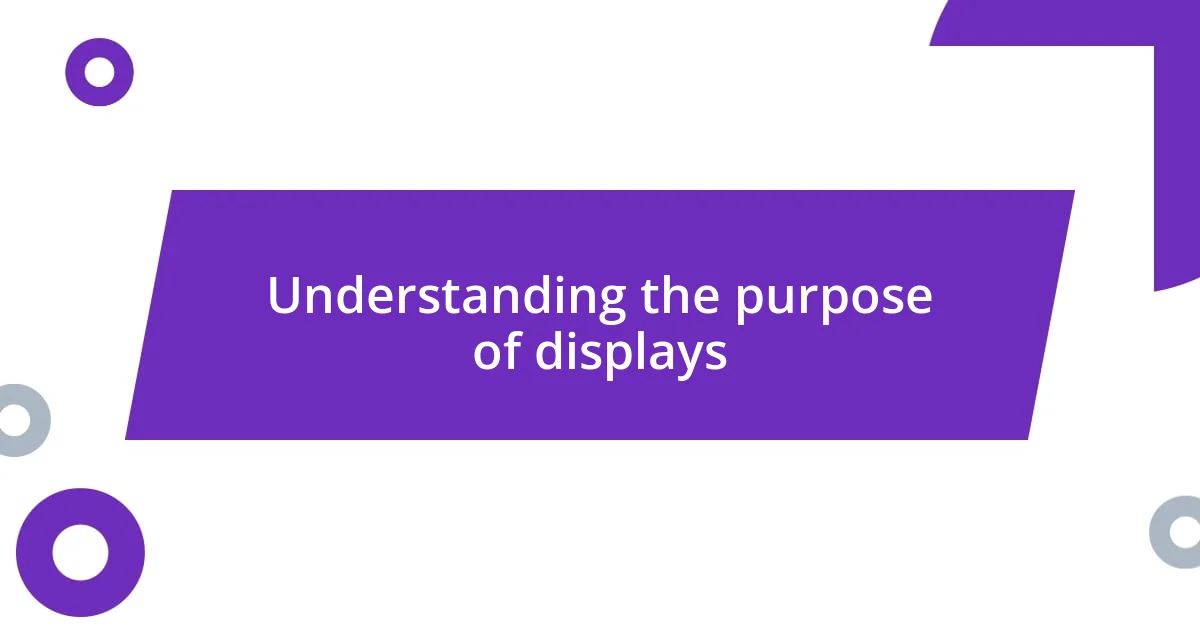
Understanding the purpose of displays
Displays serve multiple purposes, and understanding them is crucial for creating impactful visual experiences. Take, for instance, that feeling of excitement I get when I walk into a store and see a beautifully arranged display; it draws me in, creates a connection, and can even spark a desire to purchase something I didn’t plan on buying.
Have you ever noticed how some displays seem to tell a story? I remember visiting an art exhibit where the arrangement of pieces led me on a journey through the artist’s inspiration. It made me stop and reflect on the emotions conveyed, which is exactly what a thoughtful display can achieve—it engages the audience on a deeper level, transforming passive viewers into active participants in the narrative.
Moreover, displays act as a bridge between brands and consumers, offering a unique opportunity to communicate messages without words. When I see a display that sparkles with creativity, it almost feels like an invitation. How can we offer that same feeling in our own displays? It’s about making a genuine connection and allowing the display to resonate with the audience emotionally, prompting them to engage, explore, and ultimately discover something new.
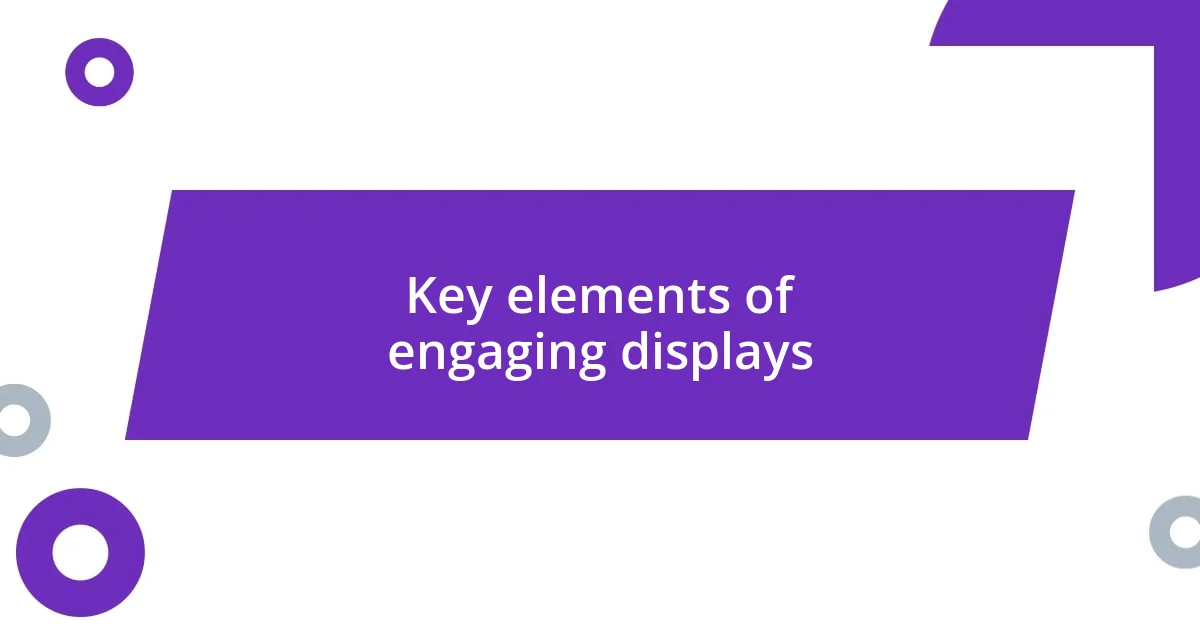
Key elements of engaging displays
Creating an engaging display is all about capturing attention and holding it long enough to inspire curiosity. When I step into a space that balances color, texture, and movement effectively, I can’t help but feel drawn toward it. The atmosphere seems to pulse with energy, making me want to explore every inch.
Here are some key elements to consider for your displays:
- Visual Hierarchy: Make sure the most important elements are immediately noticeable.
- Color Psychology: Use colors strategically to evoke emotions; bold colors can energize, while softer hues may calm.
- Interactive Elements: Incorporating touch or digital features encourages visitors to engage physically and mentally.
- Clear Messaging: Ensure your display communicates the intended message effortlessly, allowing for quick understanding.
- Narrative Flow: Arrange items in a sequence that tells a story, guiding viewers through an experience.
I recall designing a window display for a pop-up shop. I opted for bright colors and an interactive element, where customers could spin a wheel to receive discounts. The responses were fantastic! People weren’t just walking by; they stopped, engaged, and even took pictures. Seeing that excitement amplified my belief in the power of thoughtful design.
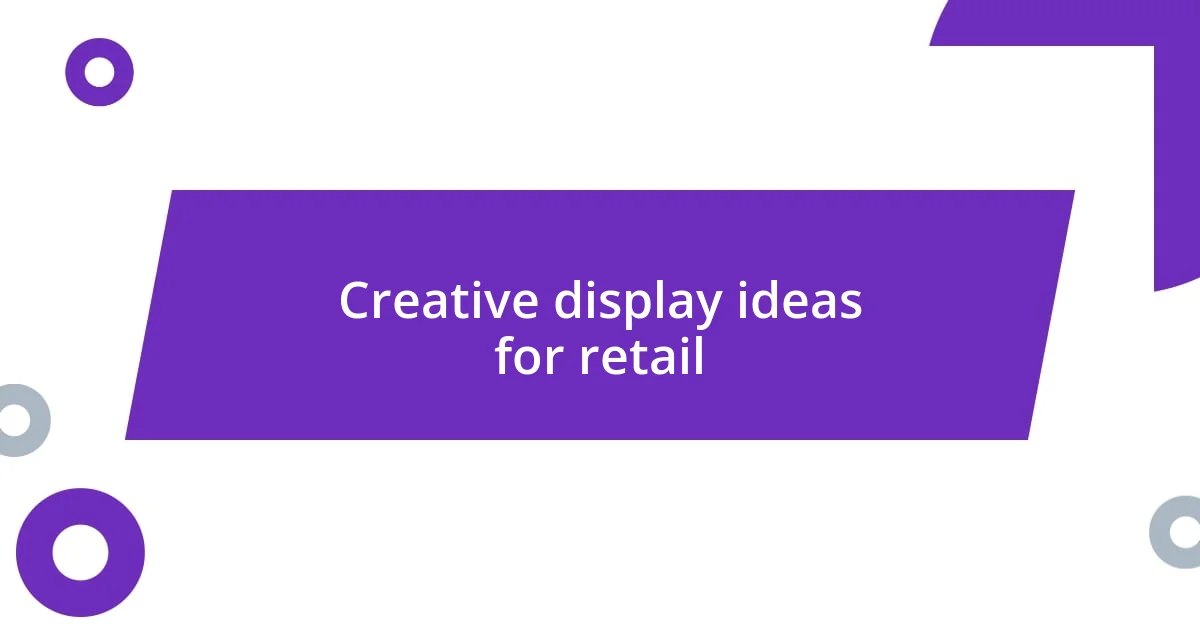
Creative display ideas for retail
Creating captivating retail displays can elevate a shopping experience significantly. One strategy that I find particularly effective is the use of seasonal themes. When I designed a fall display with rustic elements like pumpkins and warm colors, customers not only stopped to admire the setup but also felt a nostalgic connection to autumn. It’s fascinating how leveraging seasonality can evoke emotions and encourage shoppers to immerse themselves in the ambiance.
Another engaging idea centers around collaboration with local artists or creators. Once, we showcased a local artisan’s work in our window display, incorporating their unique pieces along with interactive signage. The enthusiasm from both the artist and our shoppers was palpable. It fostered a sense of community and drew foot traffic from curious locals who wanted to support homegrown talent. By creating a shared experience, our display transformed the retail space into a vibrant hub of creativity.
An often-overlooked display idea is the incorporation of sensory experiences. For instance, I’ve experimented with incorporating scents that align with the displayed products—think fresh coffee for a café or floral fragrances for a boutique. This multi-sensory approach can trigger memories and emotions, enhancing customer engagement. I once used this tactic during a holiday promotion, combining cozy scents with festive visuals, and the feedback was overwhelmingly positive—customers lingered longer, creating a warm and inviting shopping atmosphere.
| Display Idea | Emotional Impact |
|---|---|
| Seasonal Themes | Taps into nostalgia and seasonal emotions |
| Collaborative Artist Showcases | Fosters community connection and excitement |
| Sensory Experiences | Enhances engagement through memory and emotion |
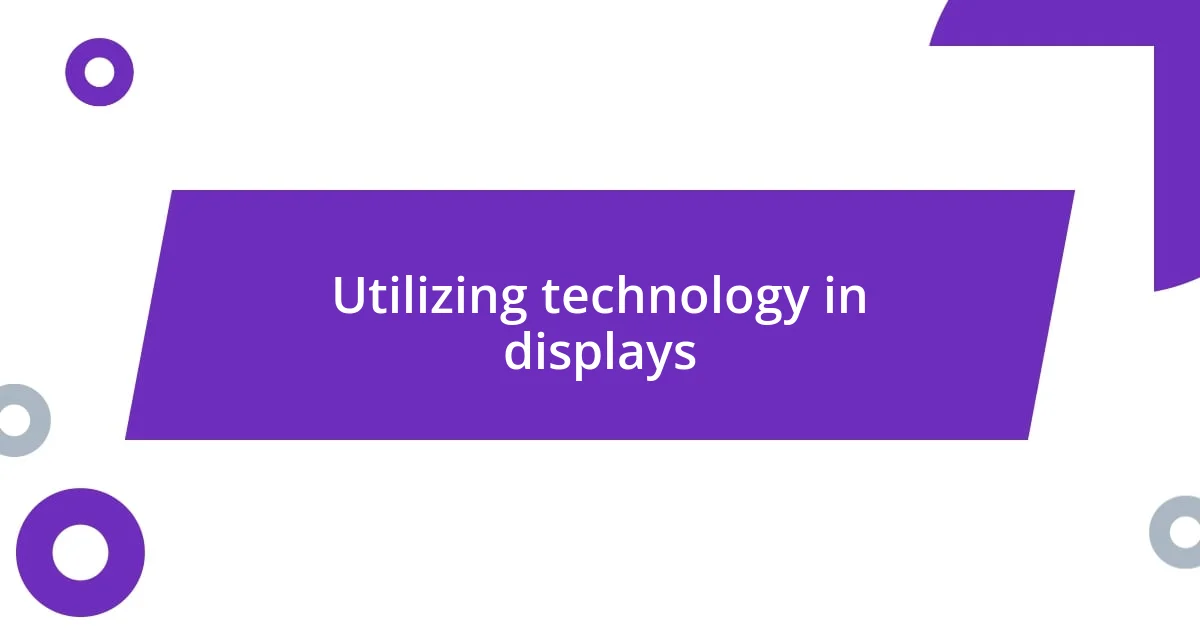
Utilizing technology in displays
Utilizing technology in displays can truly elevate the viewer’s experience. I once helped integrate augmented reality (AR) into an exhibition where visitors could use their phones to see virtual models of products in action. The response was staggering! Many patrons eagerly interacted with the AR, leading to spontaneous conversations about the features and benefits. It’s incredible how technology can turn a straightforward display into an immersive journey.
In another instance, I encountered a retail space that employed digital screens to showcase customer testimonials alongside product images. I found it fascinating how seeing real-life reviews immediately transformed perceptions. It made products feel more authentic and trustworthy—a powerful reminder that integrating user-generated content with technology can create a deeper connection with potential customers.
I also believe that interactive kiosks can significantly enhance engagement. For example, during a trade show, I observed a booth that allowed attendees to customize product features through a touchscreen. The excitement was tangible as people explored different options, often sharing their creations with friends nearby. Have you ever noticed how hands-on experiences can transform passive observation into active participation? Incorporating technology not only sparks curiosity but also encourages memorable interactions, making it a valuable tool in any display.
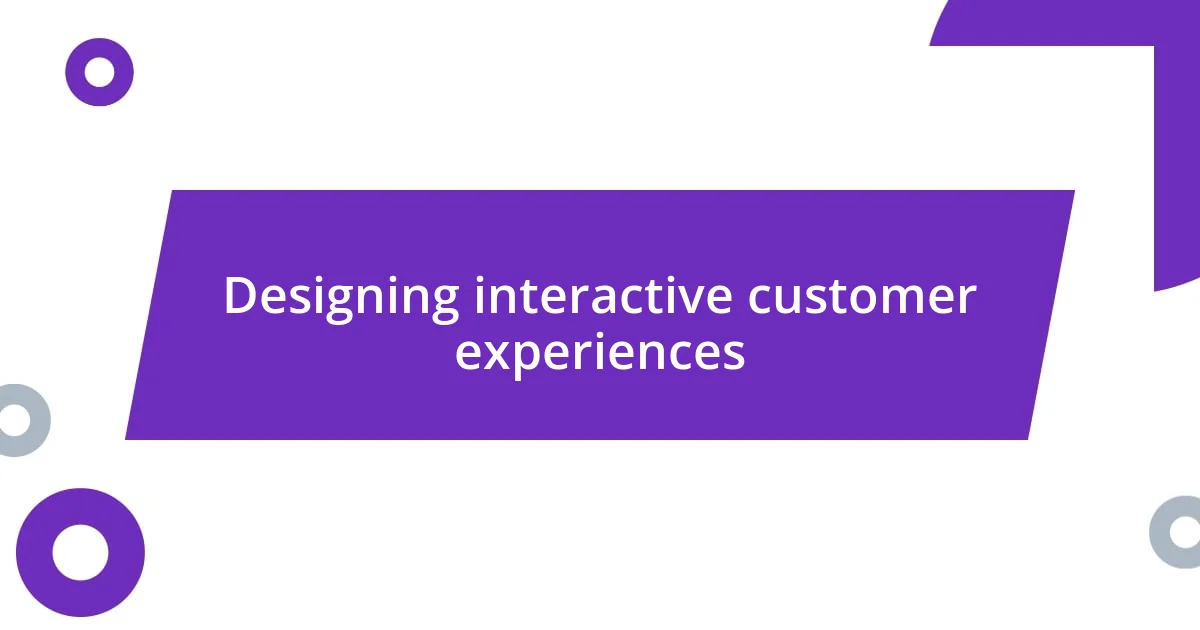
Designing interactive customer experiences
When it comes to designing interactive customer experiences, one idea that struck me was the use of immersive story-telling. I recall a time when I created a themed display that told a narrative about a product. We set up different sections to represent various chapters; customers could physically walk through and engage with each part of the story. This not only intrigued shoppers but also helped them visualize how the product fit into their lives, making the shopping experience feel more personal and meaningful.
Another impactful approach is gamification. I remember setting up a scavenger hunt in our store where customers had to find specific items based on clues hidden around the display. The thrill of the chase fueled excitement and not only increased engagement but prompted conversations among customers. It was fascinating to witness how a playful element transformed a routine shopping endeavor into an exhilarating adventure. Have you ever considered how a simple game can motivate customers to explore products they might have otherwise overlooked?
Finally, I find that incorporating feedback mechanisms can create a unique and interactive experience that resonates with customers. At one event, we set up a digital board where visitors could rate their experiences in real time. The instant feedback allowed us to adjust our displays on the fly and create a more tailored environment. That moment emphasized the importance of listening to your audience—each interaction became an opportunity for improvement, making shoppers feel valued and involved. Doesn’t it make sense to invite customers into the conversation? Their insights can be invaluable in enhancing the experience for everyone.
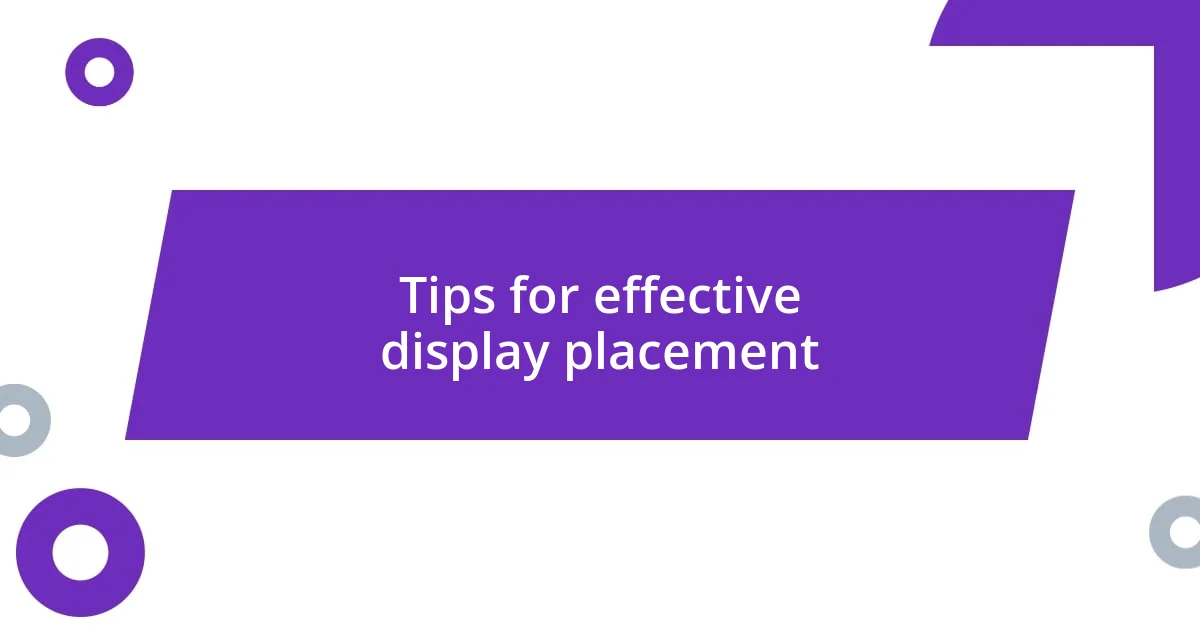
Tips for effective display placement
One of the most crucial aspects of effective display placement is visibility. I vividly remember a trade show where we positioned our main display right at the entrance. It was amazing to see how that strategic placement drew people in, ultimately resulting in a 40% increase in foot traffic compared to previous years. Have you ever noticed how something as simple as location can drastically change the dynamics of engagement?
Another vital tip is to consider the flow of movement in the space. During a pop-up event I helped design, we created a circular layout that naturally guided visitors through the display. It felt almost like a dance, where each turn led to something new and exciting. I’ve learned that when displays complement the audience’s path, it enhances exploration and keeps them intrigued. Don’t you find it fascinating how spatial arrangement can influence curiosity?
Lastly, I strongly believe in the power of layering elements in your displays. While setting up a multi-tiered display at a retail location, I noticed how varying heights and textures created depth that captivated shoppers. It was rewarding to see customers lean in closer to examine unique items placed at different levels. This experience reinforced for me that thoughtful placement can invite interaction, making every encounter with the display feel entirely unique and worthwhile. Have you ever thought about how an eye-catching arrangement can transform the way people perceive a product?
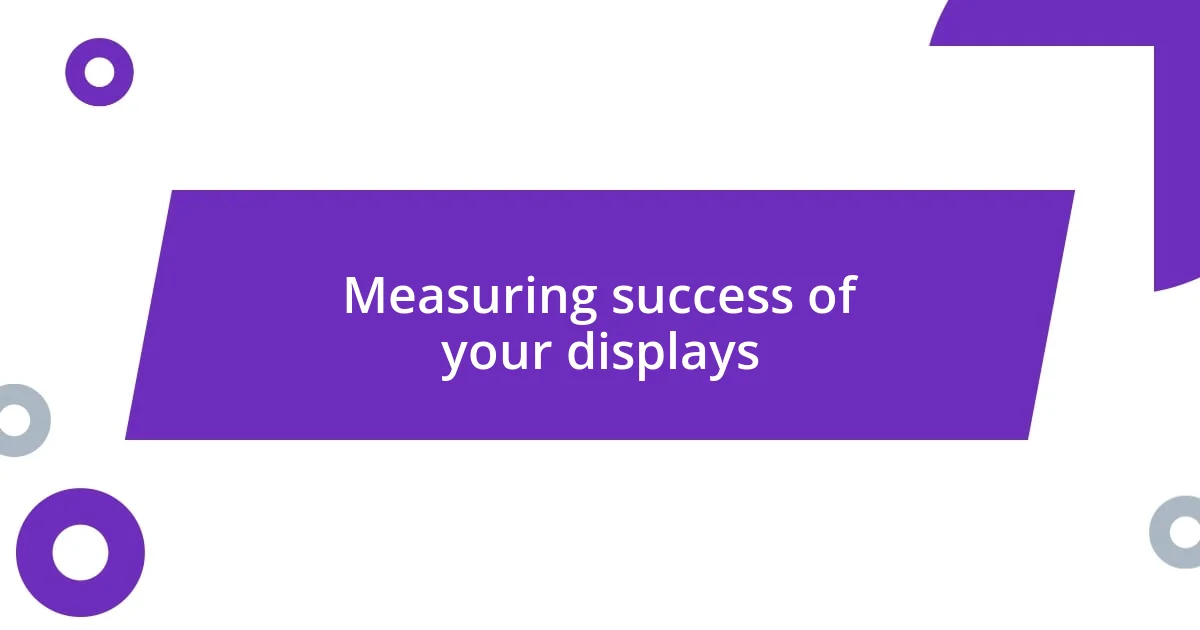
Measuring success of your displays
Measuring the success of your displays can be an eye-opening process. I remember a time when we analyzed customer engagement metrics after a product launch. By tracking foot traffic, conversion rates, and even the time spent interacting with the display, we gained insights that changed our approach moving forward. It’s incredible how data can illuminate what truly resonates with shoppers, isn’t it?
One effective way I’ve found to gauge display success is through social media engagement. At a recent event, we encouraged attendees to share their experiences online by using a specific hashtag. The influx of photos and feedback not only created a buzz but also served as a direct measure of how well our display connected with people. Have you ever noticed how powerful word-of-mouth, amplified by social platforms, can turn a simple display into a memorable experience?
Moreover, don’t underestimate the value of post-event surveys. After one of our immersive displays, I collected feedback through short questionnaires. I was pleasantly surprised by the detailed responses that revealed which elements captured attention and which fell flat. It’s a reminder that asking questions can lead to meaningful conversations, fostering a deeper understanding of customer preferences. Have you thought about how a few questions could unlock insights that elevate your future displays?














